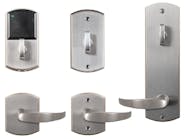Locksmiths are getting requests from homeowners and businesses to change their entry door cylindrical locks to mortise locks. One consideration is a mortise lock would create a more attractive entry having a flowing handle. For security, the end user may like the ability to have a single lock that contains both a latch and a bolt that is operated using one key and one action.
Converting from a cylindrical lock to a mortise lockset can be practical. However, several things must be taken into consideration.
The first question to ask is, “Where is the door? Is it part of a residence or a commercial building?” If the door is on a residence, there are far fewer Life Safety restrictions and local ordinances.
If the door is on a commercial building, is the door fire rated? If so, the door and the frame must be replaced to make this type of modification. If the door is not fire rated, there is a good likelihood the conversion can be accomplished and still meet code(s). When in doubt, contact your locksmith distributor or the lock manufacturer.
Another important consideration is, “Is the door painted or does it have a wood finish?” Most sectional (rose) mortise lock trim will not cover the cross bore opening if the lock is installed at the same latch centerline height. It may be possible to use a sectional trim equipped mortise lock if the roses are larger than 2-1/8” in diameter. Escutcheon trim (one single plate) on the front and back can work; however, the trim must be wide enough to cover the cylindrical lock’s 2-1/8” wide cross bore opening.
To modify the door’s lock preparation from a cylindrical to a mortise configuration, I used a Pro-Lok® INJIG-MORT self-centering Mortise Jig to cut the mortise pocket into the edge of the door. The INJIG-MORT is designed to cut a mortise pocket up to 12 inches tall by up to six inches deep. The height of the mortise pocket and the faceplate is determined by the positioning of the two sets of clamps. The clamps provide the stops for the mortising tool by limiting the travel of the housing assembly.
Cutters for this tool are designed for wood or aluminum. The wood cutters included in this kit are 7/8”, 1” and 1-1/16” diameter. I mortised the pocket using the 1” diameter cutter and then used the 1-1/16” diameter cutter to mortise the opening for the front of the mortise lock body and the faceplate.
For this installation article, I removed a SARGENT 7 Series leverset from a door blank and installed a SARGENT 8200 Series mortise lock trim with the WT escutcheon and L lever. The WT escutcheon is a full length trim that extends above and below the mortise lock body. To order this complete mortise lock, the part number is SARGENT 8243WTL. As a possible alternative, SARGENT offers the L sectional trim which has a 3-1/2” diameter rose. The L rose should be large enough to cover the cross bore in order to convert a cylindrical lockset door prep to accommodate the SARGENT mortise lock.
The door blank used for this installation article has a solid (particle) core within a wood frame. Because the door’s core was not solid wood, I could make very deep cuts to create the mortise pocket.
Important: If you are mortising a solid wood door, use a number of very shallow cuts to prevent damaging the door.
To determine the location for the mortise pocket, I drew the outer shape of the mortise lock against the side of the door with the lock’s latch positioned in the same height as the cylindrical lock latch edge bore. Then I placed a line at the top and the bottom of the mortise lock front. From this, I drew four horizontal lines on the lock edge of the door, locating the top and bottom of the mortise body and the top and bottom of the front. If the door has a finish, use blue painter’s tape that can be written on and removed from a finished surface without causing damage.
Once I had made my marks for the installation, I needed to mount the Pro-Lok INJIG-MORT onto the door. I located and adjusted the mortising tool clamping mechanism above and below the area of the mortise pocket. I over sized the opening approximately 3/8” to ensure the pocket top and bottom would accommodate the mortise lock body. Even if the pocket was a bit larger, it would not affect the installation as long as the mounting screw holes were still in the uncut portion of the rail.
I adjusted the depth ring on the plunger for approximately half of the needed cut by placing the mortise body above the plunger and sliding the depth ring to the desired location. I used the included hex wrench to secure the depth ring in place.
With the two sets of clamps firmly tightened onto the edge of the door, I began to cut the mortise pocket using the 1” diameter cutter, keeping the pocket relatively clear of saw dust. Once half the depth was cut, I adjusted the depth ring and completed the pocket.
The next step was to adjust the height for the front, change the cutter and adjust the depth ring. This time, the cut had to be slightly smaller than the overall length of the front to ensure that just the right amount of door edge was removed. I used a chisel and hammer to finish the opening.
Important: Use a vacuum to remove as much of the wood debris as possible several times when cutting the mortise pocket. Always vacuum before inserting the mortise body into the pocket. This will keep the mortise lock mechanism in better working condition.
With the completed mortise pocket, it is time to cut the openings for the spindles and the slide adapters, the mortise cylinder and the turn lever assembly. First I placed the mortise lock into the pocket. I then placed the outside front onto the lock body and checked the alignment. It was flush with the edge of the door.
Next, determine the locations for the door prep. The hub was visible at the lower edge of the 2-1/8” diameter cross bore. I positioned the template onto the door face aligning it with the hub and the visible through-bolt opening.
I then marked the center of the mortise cylinder opening and the turn lever assembly opening. I removed the mortise lock body and drilled the four additional holes including the two through-bolt openings. I then enlarged the spindle holes to accommodate the slide adapters.
Once the openings were drilled, I vacuumed the wood debris and began to install the mortise lock and components. Everything fit together and the lock mechanism was operable using the key, levers, toggle lock/unlock and the turn lever assembly.
For more information regarding SARGENT cylindrical or mortise locks, contact your local locksmith distributor or SARGENT Manufacturing Company, telephone 800-727-5477 or Web Site: www.SARGENTlock.com
For information regarding Pro-Lok mortising products, contact your local locksmith distributor or Pro-Lok, 655 North Hariton Street, Orange, CA 92868. Telephone: 714-633-0681.
Website: www.pro-lok.com




